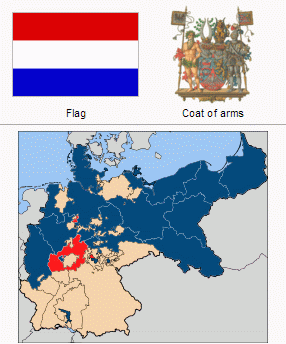Hesse-Nassau (Prussia)

Source: Wikipedia Commons
Hesse-Nassau (Hessen-Nassau) was formerly a province of Prussia, area 6,504 sqare miles (15.5 square kilometers, population 2,688,922 in 1954, which was formed in 1866 principally from the former duchy of Nassau, the landgraviate Hesse-Homburg, and the free city of Frankfurt am Main, as well as the electoral principality of Hesse-Cassel, administratively divided into the two government districts of Cassel and Wiesbaden. In the treatment of the Mennonites by the governments these regions have in the course of centuries shown great contrasts. In the 16th century the Anabaptists were systematically suppressed by the governments, but favored in the 18th and 19th. In both eras, in spite of their small numbers, they exerted a lasting influence on the development of the country; in the 16th century in the sphere of religion (see Hesse) and in the 18th, of economics.
In the 18th century the Mennonites became pioneers in a new type of agriculture. The Anabaptists of the 16th century had long since been driven out and suppressed; they were replaced in the 18th century by persecuted Swiss Mennonites, who found their way into Hesse-Nassau after temporary residence in Alsace and the Palatinate. The first immigrants settled in Nassau at the end of the 18th century; they were farmers from the vicinity of Heidelberg and Mannheim. Highly pleased, von Kruse, the provincial governor, who was himself a capable agriculturist, received the Mennonites, and in 1783 he leased his estate Mosbach near Wiesbaden to Valentin Dahlem, who later became the preacher of the congregation at Wiesbaden. The estate soon became the first of the larger Mennonite model farms in Nassau-Usingen. The remaining families had received in lease from the government, farms in the districts of Wiesbaden and Idstein, where there was frequently much waste and other uncultivated land. Baron von Kruse planned systematically to turn this region, especially around Wiesbaden, where there were still hundreds of acres of waste land, into fertile land.
The achievements of the Mennonites in the culture of the soil in a short time are evident in the reports on the state of the country by the two ministers of state, von Marschall and von Jagern, to the Duke of Nassau. "Agriculture remains the chief source of German prosperity. If it were not of such high quality, how could our nation have endured so many hardships (i.e., the continental blockade). . . . Especially our Anabaptists have set a good example, neighbors from the former Lower Palatinate, and in competition with them progress has been made everywhere. The cultivation of clover has aided us. Uncultivated land grows less. Cattle-raising is thriving."
The Mennonites were now actually used as teachers of the peasants. About 1830 there were in the duchy of Nassau 14 Mennonite families with 80 souls and 17 Amish families with 130 souls (see table of distribution in ML II, 303).
From here several families settled in the electoral principality of Hesse-Cassel, the later Prussian district of Cassel. In the 1880s a member of this group, J, Schlabbach, was elected to the Prussian parliament.
At the close of the 18th century the Mennonites living around Wiesbaden organized a congregation, with Valentin Dahlem as their elder, but dissolved after his death in 1840. The Amish group met at various places for their religious services. About 1890 this congregation also became extinct.
During the 20th century a decline in numbers and a transfer of residence to the cities became evident. About 1870 the census enumeration shows 204 Mennonites in the province of Hesse-Nassau, and that of 1925 only 135, of whom 72 lived in the cities of Frankfurt, Wiesbaden, and Cassel. According to the statistics of the census in Berlin, the Mennonites were distributed through the various areas.
At the end of 1926, in the south of the Fulda area near Neuhof a Bruderhof was formed, under the leadership of Eberhard Arnold, which represented the principles of the first Anabaptists, was interested in evangelization, and in the spirit of the Hutterian Brethren carried out a community of goods, of life, and of work. In addition to a library of approximately 5,000 volumes in 1955 there were here numerous copies from old court records, Rechenschaften, letters, and songs of the 16th century Anabaptists, especially of the Hutterian Brethren. The Eberhard Arnold-Verlag was located here. A further enterprise was the children's community of the Bruderhof (see Rhönbruderhof) with its own elementary and secondary school; it also accepted a number of poor and neglected children. At the beginning of 1930 the brotherhood numbered 70 souls. The group was expelled from Germany in 1935.
A congregation was established in Frankfurt in 1948, after meetings had been held regularly since 1913. (For the small Amish settlement which existed near Marburg ca. 1780-1850, see Waldeck)
Bibliography
Correll, Ernst H. Das schweizerische Täufermennonitentum: ein soziologischer bericht. Tübingen: J.C.B. Mohr (P. Siebeck), 1925.
Die Religion in Geschichte and Gegenwart, 2.ed. Tübingen: Mohr, 1927-1932: 562, where the Hutterites are confused with the Quakers.
Hege, Christian and Christian Neff. Mennonitisches Lexikon, 4 vols. Frankfurt & Weierhof: Hege; Karlsruhe: Schneider, 1913-1967: v. II, 303 f.
Hunzinger, Abraham. Das Religions-, Kirchen- und Schulwesen der Mennoniten oder Taufgesinnten: wahr und unpartheilich dargestellt und mit besonderen Betrachtungen über einige Dogmen, und mit Verbesserungs-Vorschlägen versehen. Speyer: J. C. Kolb, 1830.
Spielmann, C. "Die Mennoniten und ihre Bedeutung für die Kultur für Nassau." Annalen des Vereins für nassauische Altertumskunde und Geschichtsforschung 26 (1894): 137-144. Reprinted in Mennonitische Blätter (1895): 19 ff.
| Author(s) | Christian Hege |
|---|---|
| Date Published | 1956 |
Cite This Article
MLA style
Hege, Christian. "Hesse-Nassau (Prussia)." Global Anabaptist Mennonite Encyclopedia Online. 1956. Web. 2 Apr 2025. https://gameo.org/index.php?title=Hesse-Nassau_(Prussia)&oldid=102233.
APA style
Hege, Christian. (1956). Hesse-Nassau (Prussia). Global Anabaptist Mennonite Encyclopedia Online. Retrieved 2 April 2025, from https://gameo.org/index.php?title=Hesse-Nassau_(Prussia)&oldid=102233.
Adapted by permission of Herald Press, Harrisonburg, Virginia, from Mennonite Encyclopedia, Vol. 2, pp. 727-728. All rights reserved.
©1996-2025 by the Global Anabaptist Mennonite Encyclopedia Online. All rights reserved.
